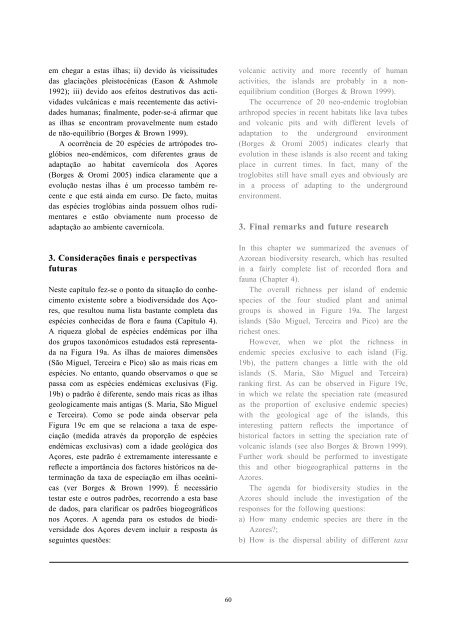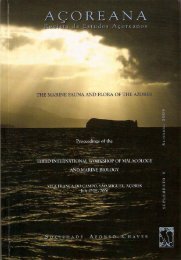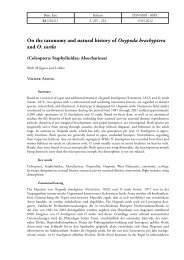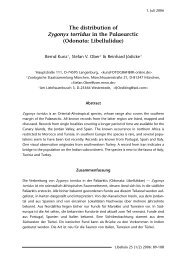(eds.) (2005). - Portal da Biodiversidade dos Açores - Universidade ...
(eds.) (2005). - Portal da Biodiversidade dos Açores - Universidade ...
(eds.) (2005). - Portal da Biodiversidade dos Açores - Universidade ...
You also want an ePaper? Increase the reach of your titles
YUMPU automatically turns print PDFs into web optimized ePapers that Google loves.
em chegar a estas ilhas; ii) devido às vicissitudes<br />
<strong>da</strong>s glaciações pleistocénicas (Eason & Ashmole<br />
1992); iii) devido aos efeitos destrutivos <strong>da</strong>s activi<strong>da</strong>des<br />
vulcânicas e mais recentemente <strong>da</strong>s activi<strong>da</strong>des<br />
humanas; finalmente, poder-se-á afirmar que<br />
as ilhas se encontram provavelmente num estado<br />
de não-equilíbrio (Borges & Brown 1999).<br />
A ocorrência de 20 espécies de artrópodes troglóbios<br />
neo-endémicos, com diferentes graus de<br />
a<strong>da</strong>ptação ao habitat cavernícola <strong>dos</strong> <strong>Açores</strong><br />
(Borges & Oromí <strong>2005</strong>) indica claramente que a<br />
evolução nestas ilhas é um processo também recente<br />
e que está ain<strong>da</strong> em curso. De facto, muitas<br />
<strong>da</strong>s espécies troglóbias ain<strong>da</strong> possuem olhos rudimentares<br />
e estão obviamente num processo de<br />
a<strong>da</strong>ptação ao ambiente cavernícola.<br />
3. Considerações finais e perspectivas<br />
futuras<br />
Neste capítulo fez-se o ponto <strong>da</strong> situação do conhecimento<br />
existente sobre a biodiversi<strong>da</strong>de <strong>dos</strong> <strong>Açores</strong>,<br />
que resultou numa lista bastante completa <strong>da</strong>s<br />
espécies conheci<strong>da</strong>s de flora e fauna (Capítulo 4).<br />
A riqueza global de espécies endémicas por ilha<br />
<strong>dos</strong> grupos taxonómicos estu<strong>da</strong><strong>dos</strong> está representa<strong>da</strong><br />
na Figura 19a. As ilhas de maiores dimensões<br />
(São Miguel, Terceira e Pico) são as mais ricas em<br />
espécies. No entanto, quando observamos o que se<br />
passa com as espécies endémicas exclusivas (Fig.<br />
19b) o padrão é diferente, sendo mais ricas as ilhas<br />
geologicamente mais antigas (S. Maria, São Miguel<br />
e Terceira). Como se pode ain<strong>da</strong> observar pela<br />
Figura 19c em que se relaciona a taxa de especiação<br />
(medi<strong>da</strong> através <strong>da</strong> proporção de espécies<br />
endémicas exclusivas) com a i<strong>da</strong>de geológica <strong>dos</strong><br />
<strong>Açores</strong>, este padrão é extremamente interessante e<br />
reflecte a importância <strong>dos</strong> factores históricos na determinação<br />
<strong>da</strong> taxa de especiação em ilhas oceânicas<br />
(ver Borges & Brown 1999). É necessário<br />
testar este e outros padrões, recorrendo a esta base<br />
de <strong>da</strong><strong>dos</strong>, para clarificar os padrões biogeográficos<br />
nos <strong>Açores</strong>. A agen<strong>da</strong> para os estu<strong>dos</strong> de biodiversi<strong>da</strong>de<br />
<strong>dos</strong> <strong>Açores</strong> devem incluir a resposta às<br />
seguintes questões:<br />
60<br />
volcanic activity and more recently of human<br />
activities, the islands are probably in a nonequilibrium<br />
condition (Borges & Brown 1999).<br />
The occurrence of 20 neo-endemic troglobian<br />
arthropod species in recent habitats like lava tubes<br />
and volcanic pits and with different levels of<br />
a<strong>da</strong>ptation to the underground environment<br />
(Borges & Oromí <strong>2005</strong>) indicates clearly that<br />
evolution in these islands is also recent and taking<br />
place in current times. In fact, many of the<br />
troglobites still have small eyes and obviously are<br />
in a process of a<strong>da</strong>pting to the underground<br />
environment.<br />
3. Final remarks and future research<br />
In this chapter we summarized the avenues of<br />
Azorean biodiversity research, which has resulted<br />
in a fairly complete list of recorded flora and<br />
fauna (Chapter 4).<br />
The overall richness per island of endemic<br />
species of the four studied plant and animal<br />
groups is showed in Figure 19a. The largest<br />
islands (São Miguel, Terceira and Pico) are the<br />
richest ones.<br />
However, when we plot the richness in<br />
endemic species exclusive to each island (Fig.<br />
19b), the pattern changes a little with the old<br />
islands (S. Maria, São Miguel and Terceira)<br />
ranking first. As can be observed in Figure 19c,<br />
in which we relate the speciation rate (measured<br />
as the proportion of exclusive endemic species)<br />
with the geological age of the islands, this<br />
interesting pattern reflects the importance of<br />
historical factors in setting the speciation rate of<br />
volcanic islands (see also Borges & Brown 1999).<br />
Further work should be performed to investigate<br />
this and other biogeographical patterns in the<br />
Azores.<br />
The agen<strong>da</strong> for biodiversity studies in the<br />
Azores should include the investigation of the<br />
responses for the following questions:<br />
a) How many endemic species are there in the<br />
Azores?;<br />
b) How is the dispersal ability of different taxa

















